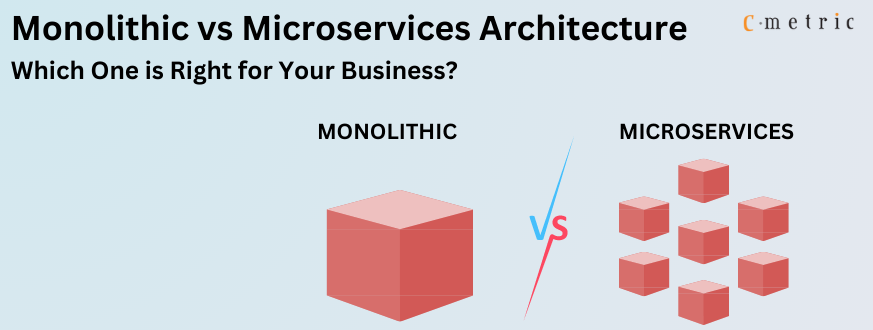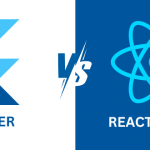When it comes to building cutting-edge applications, developers have a myriad of options. Microservices and monolithic architecture are two app-developing approaches we decided to discuss today. These two architectures often remain in the headlines because they both have a huge fan following and offer a wide range of features and facilities.
If you had a tough time making a choice between monolithic vs microservices architecture, check out this post. We will provide you with a basic definition and close comparison of both so that you can decide and select the right application development services
Monolithic Architecture – The Traditional Method
We all played with Legos. Now, imagine you’ve to build a big toy town with blocks. If you follow the monolithic approach, you have to keep the foundation of the whole town the same, and all the different units, like markets, banks, and buildings, will have connected walls. You will build all these things simultaneously.
This way, if you need to make a change in any of these town components, you have to rebuild other components as well, as they are dependent on each other. This is how monolithic architecture works in real-life.
Monolithic architecture is a primitive applications development approach wherein the concerned application is built as a whole unit. It’s developed in a self-contained manner. The key components of an application are not disintegrated and remain dependent on each other.
Here, one large computing network brings all the application components together. So, everything becomes a part of a giant system. Modification in any of the small components means modifying the main code base.
Microservices Architecture – The Advanced Application Development Process
If you follow microservices architecture to build the same toy town, the different parts of the toy town will be constructed differently. Instead of constructing a huge block, you will be constructing banks, hospitals, apartments, and other components separately. You can take the help of your friends to build different components independently.
In the software realm, microservices architecture has the same modus operandi. A big application is disintegrated into small and independent sections. The development and management of these independent components will be handled by different services/developers.
For example, one team will handle the authentication while the other will look after the payment. All these components can work independently and communicate with each other using APIs. The flexibility and freedom that you will experience with microservices is similar to cloud computing services. You have the power to customize, control, and continue.
Monolithic vs Microservices Architecture: Weighing Down The Pros And Cons
Both these architectures come with a fair share of advantages and disadvantages. If you decide to pick one out of these two, you need to learn about your gains and losses beforehand. Below is a detailed comparison of monolithic and microservices in terms of advantages and disadvantages.
Monolithic Architecture
| Advantages | Disadvantages |
| The architecture is easy to deploy and manage as one executable file handles everything. | Development is a slow and effort-consuming task as all the application components are built together. |
| Only one code base is enough to build entire applications. | Reduced scalability is a major concern in a monolithic architecture. It’s difficult to scale one component as you are required to scale everything. |
| You don’t require a huge API network to perform multiple functions. One API is enough to handle multiple jobs. | The presence of one error can collapse the entire application as its penetration can be deeper, and all the related components will be impacted hugely. |
| As monolithic architecture keeps the application unified, testing and bug removal are generally easy, as end-to-end testing will find issues anywhere in the application. | You have very limited flexibility when it comes to technology. |
| Replacing one code is enough to fix bugs and errors. | As the size of the application grows, its management becomes very difficult and tedious. |
Microservices Architecture
| Advantages | Disadvantages |
| The best part of using microservices is their unmatched agility, as it promotes agile development. | Microservices are a little complex as compared to monolithic architecture, as you need to hire different teams and manage different components. |
| As small teams can work on a project, development becomes speedy and less tedious. | Application development services with microservices are a little costly as you need to invest in multiple APIs, technologies, and developers. |
| Scalability is not an issue with microservices, as one can upsize or downsize any of the components without disturbing its peers. | You need to own different development resources for different services. |
| It promotes continuous deployment that makes version updates and new feature releases easy. | At times, it becomes difficult for a team to stay connected and collaborate in real time. |
| It’s easy to experiment with features and roll back any update if new features are not good. | While it’s great to have independent applications, debugging becomes more complicated as developers have to review different sets of codes and logs. |
| One is allowed to use multiple technologies at a time. | Microservices often lead to standardization issues as different teams are allowed to use different technologies. |
| As each component is independent of each other, bug penetration is limited. It’s easy to contain an error within a component and keep other components safe. | As many people are responsible for different application components, ownership becomes an issue as the application grows. |
| Finding errors and bugs is easy as you can find out the problem causing services easily. |
You should Also Read Our Piece of Content
How to Digitally Transform Your Business with IoT And AI | C-Metric
Monolithic vs Microservices: What to Chosen When
Now that these architectures’ basic meanings, advantages, and disadvantages are clear, it’s time to find out when to select which one.
Monolithic architecture is the best choice to make when:
- You’ve to develop a small and simple application with the least possible hassles.
- You’ve got a limited development budget. You don’t require much investment here. With one code base, you can develop the entire application.
- There is a need for tight integration between all the application components. Since this architecture keeps all the application components, integration is there.
- You don’t need a lot of scalability for the application. This approach is best for a rigid application need that doesn’t grow with the organizational needs.
- You need to have an application quickly.
Contrary to this, microservices architecture is going to help you when:
- You have to build a huge application with multiple components.
- You need to integrate great flexibility and scalability into the application.
- You can afford a high development cost.
- You have adequate talent and multiple technologies to finish the development.
- You have enough development time in your hand.
- You can manage the development resources for different application
Final Say
Monolithic and microservices architecture are two options for developing enterprise applications. As discussed and compared, each one works differently and has significant pros and cons. So if you are looking to build a large one-code base system, then make a choice with a monolithic architecture. If you want to build a small independent module based on your business functionality, go for microservices architecture.
Selecting one of these options should be based on carefully evaluating your requirements, project complexity, team structure, scalability needs, and future growth plans. If you have a tough time finding the perfect option, take the help of an expert cloud computing services provider to find the best match.















Get in Touch